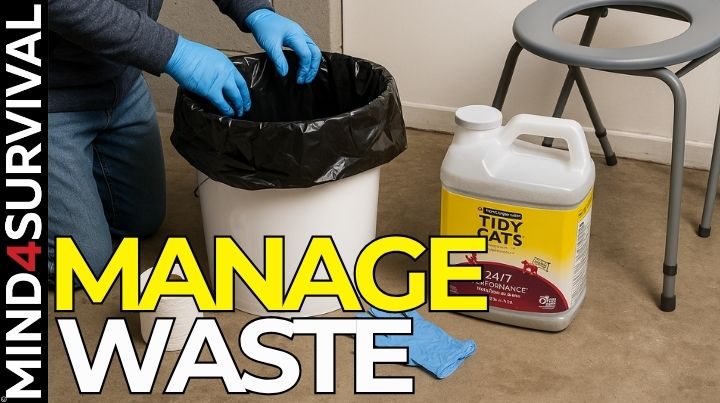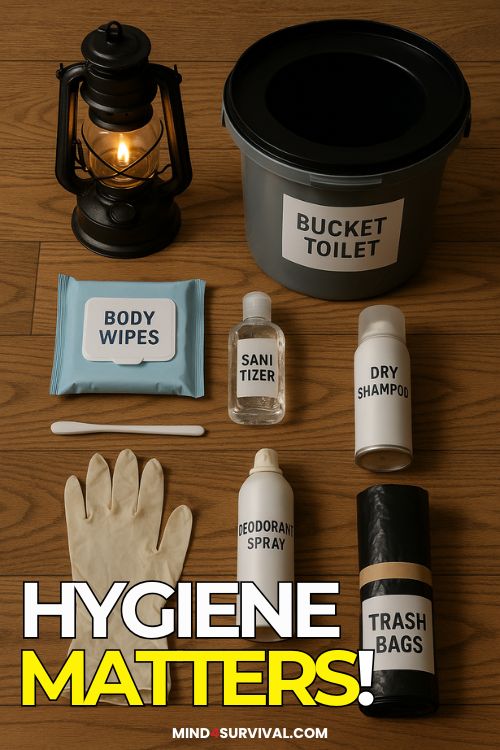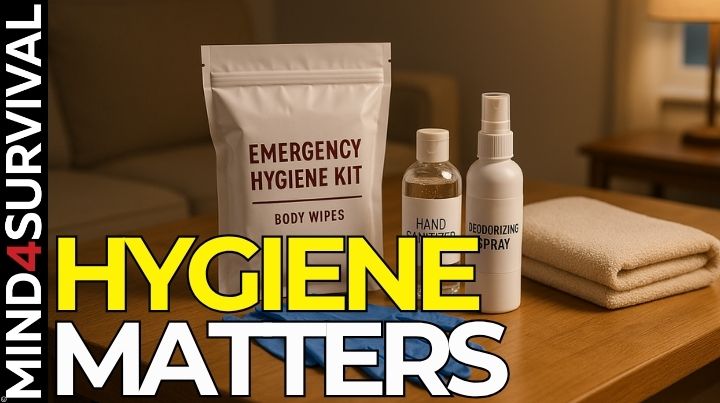My grid-down hygiene hack: before every hurricane I’ve experienced, I always line my bathtub with a plastic liner and fill it with water. That’s because there is always a chance that you will lose water in a disaster. That’s not the only thing that can be disrupted: you may also not be able to wash your hands or flush your toilet, so you will have to improvise. Maintaining hygiene is super important when the grid goes down. Poor sanitation quickly leads to the spread of illnesses, infections, and diseases, especially in crowded or small living environments, such as apartments. Make hygiene a priority in your preparedness plan-this guide will show you how.
TL;DR: You don’t need running water to stay clean. Here’s how to handle hygiene, toilets, and sanitation during a grid-down emergency—practically and safely.
Quick Look at What You’ll Learn
Conserve Water During Emergencies
Water is life—but when supply lines are damaged, it becomes one of the first resources to run dry. In small spaces with limited storage, conserving every drop becomes a priority. One of the most practical approaches is to limit flushing the toilet. The rule of thumb “if it’s yellow, let it mellow” may sound unappealing, but you may have to resort to the practice, as it drastically reduces unnecessary water use during non-urgent bathroom visits.
Washing dishes can also be water-intensive if done under a running tap. Instead, use a basin to wash and rinse dishes in batches, minimizing water usage without compromising cleanliness. Or, use disposable plates and utensils. You’ll need lots of trash bags too!
As for personal hygiene, skipping showers may be necessary. Take a tip from hospitals: during a hospital stay a few years ago, the nurse provided rinseless shampoo and soap, along with large body wipes. Stock up on full-body wipes or rinse-free washcloths. These are excellent alternatives to maintain hygiene without using precious water.
Another smart habit is to reuse greywater whenever possible. Water from dishwashing or sponge baths can be collected and used to flush toilets or water non-edible plants. Making the most out of every drop ensures that your emergency water supply lasts longer and supports multiple uses in a resource-scarce environment.
Waste Management: Keeping Spaces Clean and Hygienic
When the regular waste removal infrastructure breaks down, managing trash and sanitation becomes a priority. I stock up on tall kitchen bags as well as industrial-sized heavy-duty lawn and yard waste bags.
Proper waste segregation is essential, especially in tight living quarters. Set up a simple system with separate containers for recyclables, organic waste, and non-recyclable items. Labeling each bin can help household members maintain the routine even during stressful circumstances.
Space-saving and odor-controlling trash bins are especially useful in apartments or shelters. Look for compact bins with tightly sealing lids to contain smells and discourage pests. Empty them often to prevent the buildup of bacteria or contaminants that could affect air quality or health.
Staying Clean Without Traditional Facilities
For quick personal cleaning, dry shampoo can keep hair feeling fresh, while body or
baby wipes allow for daily wipe-downs that target the most important areas—armpits,
groin, feet, and face. These tools help maintain morale as much as hygiene, keeping
you feeling more human during uncertain times.
You can also make your own deodorizing spray.
Ingredients:
- 1 tablespoon Baking soda (sodium bicarbonate)
- Tea tree oil and Eucalyptus oil (I used Eden’s Garden but any brand should work)
- 1 cup of water
- Spray bottle
In a small jar, add the baking soda to the water. Shake it up. Then add 4 drops of tea tree oil. Tea tree oil has anti-bacterial properties but it does have a strong smell. I added 5 drops of eucalyptus oil and shook it some more. That’s it!
Carefully pour the mixture into a refillable spray bottle.
To use, spray all over areas you normally perspire and wipe off.
It’s also wise to invest in portable hygiene products designed for emergencies or travel. Hand sanitizer, biodegradable soap sheets, and disinfectant wipes are compact, effective, and don’t require a water source. Keep these in multiple areas of your home, bug-out bag, and vehicle so they’re always accessible.
Don’t neglect oral care. If you are out of toothpaste you can clean your teeth with baking soda. It may not taste great like toothpaste, but it’ll get the job done. You can also gargle with salt water, or with vodka if you don’t have mouthwash. One particularly useful strategy is setting up a DIY handwashing station. All you need is a clean container with a spigot or nozzle, biodegradable soap, and a catch basin. This makeshift sink can be placed near your food prep or toilet area, encouraging regular handwashing even when running water isn’t available.
For bathroom needs, you should consider having an emergency toilet. A simple 5-gallon bucket fitted with a seat and lined with a heavy-duty trash bag can be a lifesaver. Some preppers add an absorbent gel or sawdust to contain odors and waste. One reader once shared that she gifted potty bucket kits to her entire family for Christmas—a humorous but practical gesture. In addition, stockpile large trash bags, which can double as liners, water carriers, or emergency ponchos if needed.
Preparedness Through Knowledge and Practice
Having the right gear is only half the battle—knowing how to use it effectively under pressure is just as important. That’s where education and practice come in. Teach your family members the basics of hygiene during emergencies, from how to wash hands with limited water to the importance of regular cleaning, even when it seems optional. Emphasize that a few moments spent on cleanliness can prevent illnesses that may otherwise require medical care that isn’t available during a crisis.

Practice drills should be part of your emergency routine. Simulate a 24- or 48-hour grid-down event and follow your hygiene plan strictly. This will reveal gaps in your supplies or routine—maybe you didn’t store enough wipes, or your portable toilet is too small. Adjust your setup based on real-world practice before a real emergency forces your hand.
Emergency Hygiene Kit Checklist
Here’s a quick list to build your own hygiene survival kit:
- Baby wipes or rinse-free body wipes
- Hand sanitizer (alcohol-based)
- Bar soap and liquid soap
- Toothbrush, toothpaste, and floss
- Baking soda
- Bucket toilet + liners
- Kitty litter or bark for solid waste odor control
- Travel John or solidifying gel for liquid waste
- Trash bags and gloves
- Feminine hygiene products
- Biodegradable detergent or soap
- Disinfectants (bleach, vinegar, wipes)
- Toilet paper or reusable alternatives
- Washcloths and microfiber towels
- Small towel and nail clippers
This is just a bare bones basic list: you should supplement it with your own personal care products.
Hygiene Is Essential for Survival
In a disaster, staying clean is about much more than feeling fresh. It’s about health, safety, and resilience. Illness spreads quickly in unclean environments, and without modern healthcare access, prevention becomes your best defense.
Whether you’re in a suburban home, a studio apartment, or a tiny off-grid cabin, you can maintain hygiene even if the grid goes down. From repurposing gray water to creating portable handwashing stations, the solutions are simple and effective if you plan ahead.

Read the full article here


